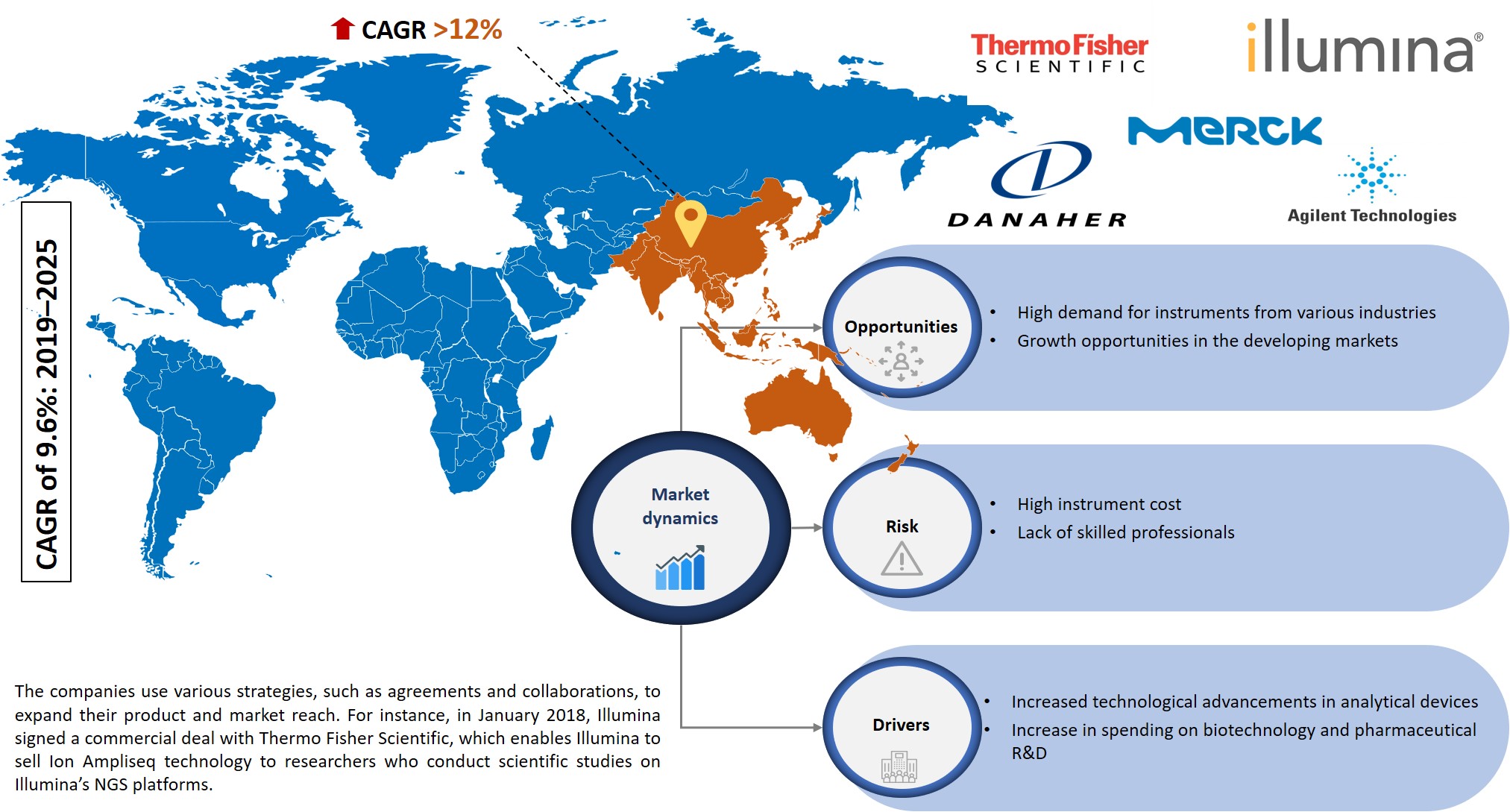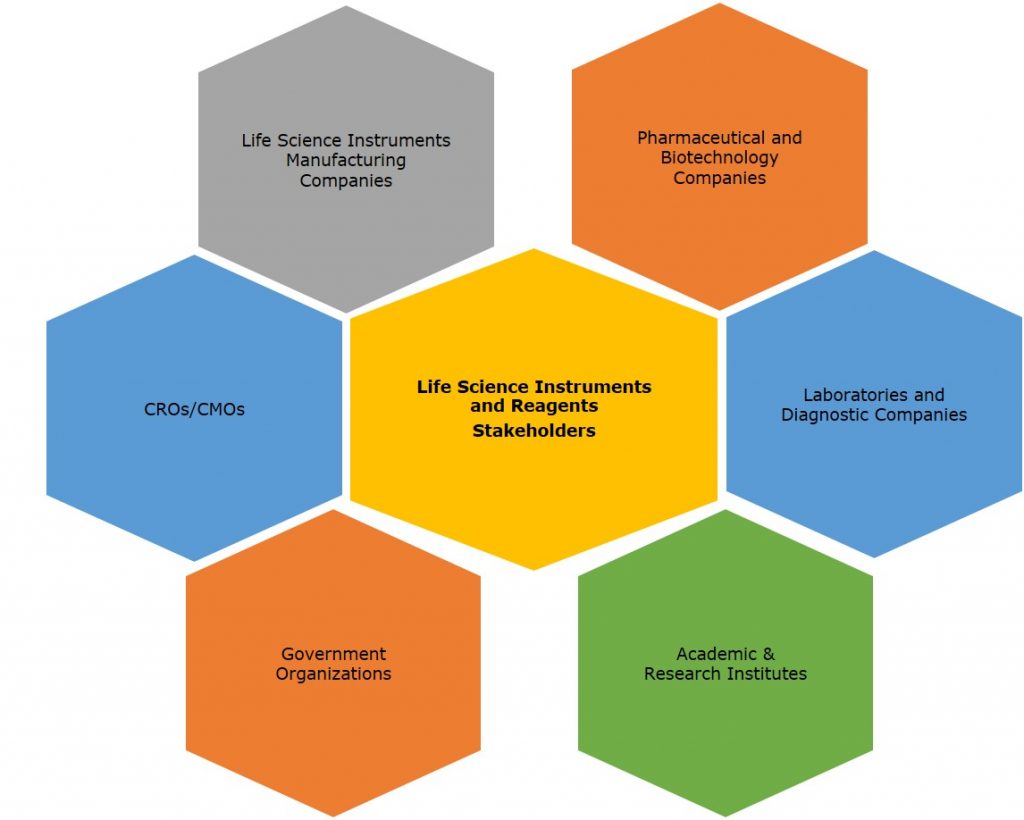
Global Life Science Instruments and Reagents Market Forecast to 2025
- April, 2019
- Domain: Healthcare - Biotechnology
- Get Free 10% Customization in this Report
[125 pages report] This market research report includes a detailed segmentation of the global life science instruments and reagents market – by technology (Spectrometry, Chromatography, Polymerase Chain Reaction (PCR), Biochips, Next-generation Sequencing (NGS), Flow Cytometry, Centrifugation, Electrophoresis, Microscopy, Liquid Handling Systems, Laboratory Freezers, and Others), and by Regions (North America, Europe, Asia Pacific, and Rest of the World).
Overview of the Global Life Science Instruments and Reagents Market Research:
Infoholic’s market research report predicts that the global life science instruments and reagents market will grow at a CAGR of 9.6% during the forecast period. The market has witnessed a steady growth in the past few years, and the development in technology with the introduction of novel products has augmented the acceptance of life science instruments in the market. The market is fueled by upsurge in chronic (including cancer), infectious, autoimmune disorders, and other types of diseases globally, growing interest & increasing awareness levels about the benefits of early-stage diagnosis, increasing spending on R&D by biotechnology & pharmaceutical firms, and growing adoption of emerging innovative applications, particularly in the life sciences industry.

Globally, the market continues to grow steadily with all technologies used widely by pharmaceutical, biotechnology, and diagnostic companies. The vendors are focusing on new product introduction and targeting toward end-user’s perspective. The industry consolidation rate is increasing as well because of mergers, acquisitions, and collaborations in the major markets of the US and Europe. In the mature markets, the leading vendors are focusing on new product launches and fast approvals as there is an increase in demand for developing new diagnostic procedures. This has led to an increase in R&D expenditure by the leading companies, mainly in the field of NGS, oligonucleotides-based reagents/assays, and other emerging areas within biological science. The industry concentration is medium to high with the majority of the revenue being generated by the key players operating in this field; few of them include Thermo Fisher Scientific, Inc., Illumina, Inc., Agilent Technologies, Inc., Merck KGaA, and Danaher Corporation.
According to Infoholic Research analysis, North America accounted for the largest share of the global life science instruments and reagents market in 2018 and will retain a high position during the forecast period. North America is followed by Europe with a share of more than 25% of the global market in 2018. The presence of a large number of biotechnology and pharmaceutical companies in North America makes it a dominant region in the global life science instruments and reagents market. Asia Pacific is projected to grow at a double-digit CAGR during the forecast period, owing to factors such as early adoption of novel technologies, increasing funding for healthcare research, growing healthcare expenditure, and favorable regulatory environment.
Life Science Instruments and Reagents Market Research By Technology:
- Spectrometry
- Chromatography
- Polymerase Chain Reaction (PCR)
- Biochips
- Next-generation Sequencing (NGS)
- Flow Cytometry
- Centrifugation
- Electrophoresis
- Microscopy
- Liquid Handling Systems
- Laboratory Freezers
- Others
In 2018, the spectrometry segment accounted for the largest share and is expected to grow at a mid-single-digit CAGR during the forecast period. The NGS segment is expected to grow at a high CAGR during the forecast period 2019–2025 due to emerging diagnostic applications, continuous technological advancements, and more efficient & user-friendly techniques.
Life Science Instruments and Reagents Market Research By Regions:
- North America
- Europe
- Asia Pacific
- Rest of the World
The market is dominated by the US (North America), followed by Europe and Asia Pacific. The US occupied a significant share mainly due to the presence of key vendors and the availability of advanced technologies.
Global Life Science Instruments and Reagents Market Research Competitive Analysis: The global life science instruments and reagents market has massive growth opportunities in both developed and developing regions. The innovation in instruments and reagents will increase the competition among the market players.
Many companies are focused on product approvals, funding, and development of new products related to life science instruments and reagents due to the increase in the demand for developing new diagnostic procedures. For instance, in November 2018, Thermo Fisher Scientific launched its FTIR spectrometer known as Nicolet iS20. The instrument features a new LightDrive Optical technology that enhances the analysis of complex samples to provide fast and accurate results. Exactly a year before, in November 2017, GNA Biosolutions GmbH had launched Pharos V8, the world’s first Laser PCR platform.
Another example is the launch of new INVENIO Fourier Transform Infrared (FT-IR) research spectrometer by Bruker in April 2018. This instrument is the successor to the renowned VERTEX 70 FT-IR for advanced R&D applications. In addition, other leading vendors are focusing on hugely investing in R&D activities to develop new products to obtain a high share in the market.
Key Vendors:
- Thermo Fisher Scientific, Inc.
- Illumina, Inc.
- Agilent Technologies, Inc.
- Merck KGaA
- Danaher Corporation
- Becton Dickinson and Company
- Hoffmann-La Roche (Roche)
- Bio-Rad Laboratories
- Promega Corporation
- GE Healthcare
- PerkinElmer, Inc.
- Bruker Corporation
- Waters Corporation
Key Competitive Facts:
- The market is highly competitive with all the players competing to gain the market share. Intense competition, rapid advancements in technology, frequent changes in government policies, and the prices are the key factors that confront the market.
- The requirement of high initial investment for the installation of certain life science instruments and maintenance cost in the market are also limiting the entry of new players.
Benefits – The report provides complete details about the usage and adoption rate of life science instruments and reagents. Thus, the key stakeholders can know about the major trends, drivers, investments, vertical player’s initiatives, and government initiatives toward the medical devices segment in the upcoming years along with details of the pureplay companies entering the market. Moreover, the report provides details about the major challenges that are going to impact the market growth. Additionally, the report gives complete details about the key business opportunities to key stakeholders in order to expand their business and capture the revenue in specific verticals, and to analyze before investing or expanding the business in this market.
Key Takeaways:
- Understanding the potential market opportunity with precise market size and forecast data.
- Detailed market analysis focusing on the growth of life science instruments and reagents
- Factors influencing the growth of the life science instruments and reagents
- In-depth competitive analysis of dominant and pure-play vendors.
- Prediction analysis of the life science instruments and reagents industry in both developed and developing regions.
- Key insights related to major segments of the life science instruments and reagents
- Latest market trend analysis impacting the buying behavior of the consumers.
Key Stakeholders:

1 Industry Outlook
1.1 Industry Overview
1.2 Total Addressable Market
2 Report Outline
2.1 Report Scope
2.2 Report Summary
2.3 Research Methodology
2.4 Report Assumptions
3 Market Snapshot
3.1 Market Definition – Infoholic Research
3.2 Segmented Addressable Market
3.3 Trends in the Life Science Instruments and Reagents Market
3.4 Related Markets
3.4.1 Polymerase Chain Reaction (PCR)
3.4.2 Next-generation Sequencing (NGS)
3.4.3 Microarray
4 Market Outlook
4.1 Regulatory Scenario
4.1.1 North America
4.1.2 Europe
4.1.3 Asia
4.2 Market segmentation
4.3 PEST Analysis
4.4 Porter 5(Five) Forces
5 Market Characteristics
5.1 DRO – Market Dynamics
5.1.1 Drivers
5.1.1.1 Increased technological advancements in analytical devices
5.1.1.2 Increase in spending on biotechnology and pharmaceutical R&D
5.1.2 Opportunities
5.1.2.1 High demand for the instrument from various industries
5.1.2.2 Growth opportunities in the developing market
5.1.3 Restraints
5.1.3.1 High instrument cost
5.1.3.2 Lack of skilled professionals
5.2 DRO – Impact Analysis
5.3 Key Stakeholders
6 Technology: Market Size and Analysis
6.1 Overview
6.2 Spectrometry
6.3 Chromatography
6.4 Polymerase Chain Reaction
6.5 Biochips
6.6 Next-generation Sequencing
6.7 Flow Cytometry
6.8 Centrifugation
6.9 Electrophoresis
6.10 Microscopy
6.11 Liquid Handling Systems
6.12 Laboratory Freezers
6.13 Others
7 Regions: Market Size and Analysis
7.1 Overview
7.2 North America
7.3 Europe
7.4 Asia Pacific
7.5 Rest of the World
8 Competitive Landscape
8.1 Overview
9 Vendor Profiles
9.1 Thermo Fisher Scientific Inc.
9.1.1 Overview
9.1.2 Business Units
9.1.3 Geographic Presence
9.1.4 Business Focus
9.1.5 SWOT Analysis
9.1.6 Business Strategies
9.2 Illumina Inc.
9.2.1 Overview
9.2.2 Business Units
9.2.3 Geographic Presence
9.2.4 Business Focus
9.2.5 SWOT Analysis
9.2.6 Business Strategies
9.3 Danaher Corporation
9.3.1 Overview
9.3.2 Business Units
9.3.3 Geographic Revenue
9.3.4 Business Focus
9.3.5 SWOT Analysis
9.3.6 Business Strategies
9.4 Agilent Technologies Inc.
9.4.1 Overview
9.4.2 Business Units
9.4.3 Geographic Revenue
9.4.4 Business Focus
9.4.5 SWOT Analysis
9.4.6 Business Strategies
9.5 Merck KGaA
9.5.1 Overview
9.5.2 Business Units
9.5.3 Geographic Revenue
9.5.4 Business Focus
9.5.5 SWOT Analysis
9.5.6 Business Strategies
10 Companies to Watch For
10.1 Becton Dickinson and Company
10.1.1 Overview
10.2 Bio-Rad Laboratories
10.2.1 Overview
10.3 F. Hoffmann-La Roche
10.3.1 Overview
10.4 Shimadzu Corp.
10.4.1 Overview
10.5 GE Healthcare
10.5.1 Overview
10.6 Promega Corporation
10.6.1 Overview
10.7 Bruker Corporation
10.7.1 Overview
10.8 PerkinElmer, Inc.
10.8.1 Overview
10.9 Waters Corporation
10.9.1 Overview
11 Annexure
11.1 Abbreviations
Research Framework
Infoholic research works on a holistic 360° approach in order to deliver high quality, validated and reliable information in our market reports. The Market estimation and forecasting involves following steps:
- Data Collation (Primary & Secondary)
- In-house Estimation (Based on proprietary data bases and Models)
- Market Triangulation
- Forecasting

Market related information is congregated from both primary and secondary sources.
Primary sources
involved participants from all global stakeholders such as Solution providers, service providers, Industry associations, thought leaders etc. across levels such as CXOs, VPs and managers. Plus, our in-house industry experts having decades of industry experience contribute their consulting and advisory services.
Secondary sources
include public sources such as regulatory frameworks, government IT spending, government demographic indicators, industry association statistics, and company publications along with paid sources such as Factiva, OneSource, Bloomberg among others.
